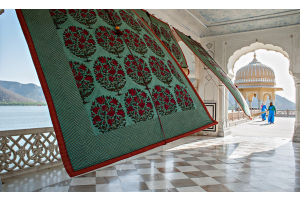- My Account
- My Wish List
- Compare Products
- Register
As per Government instructions we are not accepting orders due to COVID.
Hand Blocks


It takes great skill to create fluid dynamic designs with a wooden block. Usually the number of colors needed coincides with the number of blocks required for a design. Because cost increase per meter; designs generally contain no more than 5 to 6 bocks. ln contrast, minimal designs use 1 to 2 blocks to achieve maximum effect. Originally printing blocks were tiny and light to allow greater control and accuracy while printing. Today blocks are 6X6 inches but they can be larger. Bigger blocks enable a printer to work faster, but can be cumbersome so the printer must be well trained or quality is sacrificed.
Blocks are typically made from seasoned Shisham (Indian Rose wood). Roida (a Local desert wood) is also used to make blocks. The circular cross section must be free of any knots or imperfections. Blocks are planed and sanded for a smooth finish then whitened with a chalk paste. The carver traces a design into the surface before he begins. Working without the aid of electrical machinery, craftsmen rely upon traditional hand tools so intricate blocks may take six days or longer to compete depending upon the difficulty of the pattern.

BLOCK- PRINTING STAGES
The number of blocks needed for a design often depends upon the number of colors in the print. An average design has 1 gudh (Background), 1 rekh (Outline) and 3 to 5 datta (filler-blocks); however intricate patterns may require 2 gudh blocks and 2 to 3 rekh blocks and 7 to 13 datta blocks.


